
Инструкция по применению ОТУЛЬФИ 45 мг РАСТВОР ДЛЯ ИНЪЕКЦИЙ В ПРЕДНАПОЛНЕННОМ ШПРИЦЕ
Введение
Прошпект: информация для пациента
Отульфи 45мг раствор для инъекций в предварительно заполненном шприце
устекинумаб
Это лекарство подлежит дополнительному наблюдению, что ускорит обнаружение новой информации о его безопасности. Вы можете внести свой вклад, сообщая о побочных эффектах, которые вы можете испытывать. В конце раздела 4 содержится информация о том, как сообщать о этих побочных эффектах.
Прочитайте весь прошпект внимательно перед началом использования этого лекарства, поскольку он содержит важную информацию для вас.
Этот прошпект составлен для человека, который использует лекарство. Если вы являетесь родителем или опекуном ребенка, которому будет введен Отульфи, пожалуйста, внимательно прочитайте эту информацию.
- Сохраните этот прошпект, поскольку вам может потребоваться прочитать его снова.
- Если у вас есть какие-либо вопросы, проконсультируйтесь с вашим врачом или фармацевтом.
- Это лекарство было назначено только вам, и не следует давать его другим людям, даже если они имеют те же симптомы, что и вы, поскольку оно может нанести им вред.
- Если вы испытываете побочные эффекты, проконсультируйтесь с вашим врачом или фармацевтом, даже если это побочные эффекты, которые не указаны в этом прошпекте. См. раздел 4.
Содержание прошпекта
- Что такое Отульфи и для чего он используется
- Что вам нужно знать перед началом использования Отульфи
- Как использовать Отульфи
- Возможные побочные эффекты
- Хранение Отульфи
- Содержание упаковки и дополнительная информация
1. Что такое Отульфи и для чего он используется
Что такое Отульфи
Отульфи содержит активное вещество "устекинумаб", моноклональное антитело. Моноклональные антитела - это белки, которые идентифицируют и специфически связываются с определенными белками организма.
Отульфи относится к группе лекарств, называемых "иммунодепрессантами". Эти лекарства действуют путем ослабления части иммунной системы.
Для чего используется Отульфи
Отульфи используется для лечения следующих воспалительных заболеваний:
- Псориаз в виде бляшек - у взрослых и детей от 6 лет и старше
- Псориатический артрит - у взрослых
- Болезнь Крона средней и тяжелой степени - у взрослых
Псориаз в виде бляшек
Псориаз в виде бляшек - это заболевание кожи, которое вызывает воспаление, поражая кожу и ногти. Отульфи снижает воспаление и другие признаки заболевания.
Отульфи используется у взрослых с псориазом в виде бляшек средней и тяжелой степени, которые не могут использовать циклоспорин, метотрексат или фототерапию, или когда эти методы лечения не эффективны.
Отульфи используется у детей и подростков от 6 лет и старше с псориазом в виде бляшек средней и тяжелой степени, которые не могут переносить фототерапию или другие системные методы лечения, или когда эти методы лечения не эффективны.
Псориатический артрит
Псориатический артрит - это воспалительное заболевание суставов, которое обычно сопровождается псориазом. Если у вас активный псориатический артрит, сначала вам будут назначены другие лекарства. Если вы не реагируете хорошо на эти лекарства, вам может быть назначен Отульфи для:
- Снижения признаков и симптомов вашего заболевания.
- Улучшения вашей физической функции.
- Снижения повреждения суставов.
Болезнь Крона
Болезнь Крона - это воспалительное заболевание кишечника. Если у вас болезнь Крона, сначала вам будут назначены другие лекарства. Если вы не реагируете адекватно или не переносите эти лекарства, вам может быть назначен Отульфи для снижения признаков и симптомов вашего заболевания.
2. Что вам нужно знать перед началом использования Отульфи
Не используйте Отульфи
- Если вы аллергичны к устекинумабуили к любому другому компоненту этого лекарства (перечисленному в разделе 6).
- Если у вас есть активная инфекция, которую ваш врач считает важной.
Если вы не уверены, что какой-либо из этих пунктов относится к вам, проконсультируйтесь с вашим врачом или фармацевтом перед использованием Отульфи.
Предостережения и меры предосторожности
Проконсультируйтесь с вашим врачом или фармацевтом перед началом использования Отульфи. Ваш врач проверит ваше состояние перед каждым лечением. Убедитесь, что вы сообщите вашему врачу о любом заболевании, которое у вас есть, перед каждым лечением. Ваш врач также спросит, были ли вы недавно рядом с кем-то, кто мог иметь туберкулез. Ваш врач осмотрит вас и проведет тест на обнаружение туберкулеза перед использованием Отульфи. Если ваш врач считает, что вы находитесь в группе риска туберкулеза, он может назначить вам лекарства для лечения.
Обратите внимание на серьезные побочные эффекты
Отульфи может вызывать серьезные побочные эффекты, включая аллергические реакции и инфекции. Вы должны обратить внимание на определенные признаки заболевания, пока используете Отульфи. См. полный список этих побочных эффектов в разделе "Серьезные побочные эффекты" раздела 4.
Прежде чем использовать Отульфи, скажите вашему врачу:
- Если вы когда-либо имели аллергическую реакцию на устекинумаб.Проконсультируйтесь с вашим врачом, если вы не уверены.
- Если вы когда-либо имели какой-либо тип рака– это потому, что иммунодепрессанты типа Отульфи ослабляют часть иммунной системы. Это может увеличить риск развития рака.
- Если вы получали лечение псориаза другими биологическими препаратами (лекарством, произведенным из биологического источника и обычно вводимым путем инъекции)– риск развития рака может быть выше.
- Если у вас была недавняя инфекция.
- Если у вас есть новая травма или изменение травмв области псориаза или на здоровой коже.
- Если вы когда-либо имели аллергическую реакцию на инъекцию Отульфи. См. "Обратите внимание на серьезные побочные эффекты" в разделе 4 для признаков аллергической реакции.
- Если вы принимаете любое другое лечение псориаза и/или псориатического артрита– такое как любое другое иммунодепрессивное средство или фототерапия (когда ваш организм подвергается воздействию определенного типа ультрафиолетового света (УФ)). Эти методы лечения также могут ослаблять часть иммунной системы. Не было проведено изучение использования этих методов лечения в сочетании с Отульфи. Однако возможно, что это может увеличить вероятность развития заболеваний, связанных с ослабленной иммунной системой.
- Если вы получали инъекции для лечения аллергии– неизвестно, может ли Отульфи повлиять на эти методы лечения.
- Если вам 65 лет или более– вы имеете больше шансов приобрести инфекции.
Если вы не уверены, что какой-либо из этих пунктов относится к вам, проконсультируйтесь с вашим врачом или фармацевтом перед использованием Отульфи.
Некоторые пациенты испытывали реакции, подобные системной красной волчанке, во время лечения устекинумабом, включая кожную красную волчанку или синдром, подобный системной красной волчанке. Проконсультируйтесь с вашим врачом немедленно, если вы испытываете красную, возвышенную и чешуйчатую кожную сыпь, иногда с более темным краем, в областях кожи, подверженных воздействию солнца, или если они сопровождаются болью в суставах.
Сердечные приступы и инсульты
В одном из исследований, проведенных на пациентах с псориазом, леченных устекинумабом, были обнаружены сердечные приступы и инсульты. Ваш врач будет регулярно проверять ваши факторы риска сердечно-сосудистых заболеваний и инсультов, чтобы обеспечить их адекватное лечение. Обратитесь за медицинской помощью немедленно, если вы испытываете боль в груди, слабость или необычное ощущение в одной стороне тела, паралич лица или аномалии речи или зрения.
Дети и подростки
Не рекомендуется использовать Отульфи у детей младше 6 лет с псориазом и у детей младше 18 лет с псориатическим артритом и болезнью Крона, поскольку это не было изучено в этой возрастной группе.
Использование Отульфи с другими лекарствами, вакцинами
Сообщите вашему врачу или фармацевту:
- Если вы используете, недавно использовали или можете использовать другие лекарства.
- Если вы были недавно вакцинированы или собираетесь получить вакцину. Не следует вводить определенные типы вакцин (живые вакцины) во время использования Отульфи.
- Если вы получали Отульфи во время беременности, сообщите врачу вашего ребенка о вашем лечении Отульфи перед тем, как ваш ребенок получит любую вакцину, включая живые вакцины, такие как вакцина БЦЖ (используемая для предотвращения туберкулеза). Не рекомендуется использовать живые вакцины для вашего ребенка в течение первых 12 месяцев после рождения, если вы получали Отульфи во время беременности, unless врач вашего ребенка рекомендует иное.
Беременность и лактация
- Если вы беременны, думаете, что можете быть беременной или планируете стать беременной, проконсультируйтесь с вашим врачом перед использованием этого лекарства.
- Не было обнаружено увеличения риска врожденных дефектов у детей, подвергшихся воздействию устекинумаба в утробе. Однако опыт использования устекинумаба у беременных женщин ограничен. Поэтому предпочтительно избегать использования Отульфи во время беременности.
- Если вы являетесь женщиной детородного возраста, вам рекомендуется избегать беременности и использовать адекватные методы контрацепции, пока вы используете Отульфи и в течение как минимум 15 недель после последнего лечения Отульфи.
- Устекинумаб может проникать через плаценту к плоду. Если вы получали Отульфи во время беременности, ваш ребенок может иметь повышенный риск заразиться инфекцией.
- Важно сообщить врачам вашего ребенка и другим медицинским работникам, если вы получали Отульфи во время беременности, прежде чем ваш ребенок получит любую вакцину. Не рекомендуется использовать живые вакцины, такие как вакцина БЦЖ (используемая для предотвращения туберкулеза), для вашего ребенка в течение первых 12 месяцев после рождения, если вы получали Отульфи во время беременности, unless врач вашего ребенка рекомендует иное.
- Устекинумаб может выделяться в грудное молоко в очень небольших количествах. Сообщите вашему врачу, если вы кормите грудью или планируете это делать. Вы и ваш врач решите, следует ли вам кормить грудью или использовать Отульфи. Не делайте этого одновременно.
Вождение и использование машин
Влияние Отульфи на способность управлять транспортными средствами и использовать машины является незначительным или отсутствует.
Отульфи содержит натрий
Отульфи содержит менее 1 ммоль натрия (23 мг) на дозу; это означает, что он практически "не содержит натрия". Однако перед тем, как вам будет введен Отульфи, он смешивается с раствором, содержащим натрий. Проконсультируйтесь с вашим врачом, если вы придерживаетесь диеты с низким содержанием соли.
Отульфи содержит полисорбаты
Это лекарство содержит 0,02 мг полисорбата 80 в каждом предварительно заполненном шприце, что эквивалентно 0,04 мг/мл. Полисорбаты могут вызывать аллергические реакции. Сообщите вашему врачу, если у вас есть известная аллергия.
3. Как использовать Отульфи
Отульфи должен использоваться под руководством и наблюдением врача с опытом лечения заболеваний, для которых показан Отульфи.
Всегда следуйте точно инструкциям по введению этого лекарства, указанным вашим врачом. Если у вас есть сомнения, проконсультируйтесь с вашим врачом. Спросите вашего врача, когда вам следует вводить инъекции и о последующих приемах.
Какая доза Отульфи вводится
Ваш врач решит, какая доза Отульфи вам необходима, и как долго будет длиться лечение.
Взрослые от 18 лет и старше
Псориаз или псориатический артрит
- Рекомендуемая начальная доза составляет 45 мг Отульфи. Пациенты, вес которых превышает 100 кг, могут начать с дозы 90 мг вместо 45 мг.
- После начальной дозы вы примете следующую дозу через 4 недели, а затем каждые 12 недель. Последующие дозы обычно такие же, как начальная доза.
Болезнь Крона
- Во время лечения врач введет вам первую дозу примерно 6 мг/кг Отульфи путем внутривенного введения в вену руки (инфузии). После начальной дозы вы получите следующую дозу 90 мг Отульфи через 8 недель, а затем каждые 12 недель путем подкожной инъекции.
- У некоторых пациентов после первой подкожной инъекции вводятся 90 мг Отульфи каждые 8 недель. Ваш врач решит, когда вам следует получить следующую дозу.
Дети и подростки от 6 лет и старше
Псориаз
- Ваш врач укажет вам правильную дозу, включая количество (объем) Отульфи, которое необходимо ввести для получения правильной дозы. Правильная доза для вас будет зависеть от вашего веса тела в момент введения каждой дозы.
- Если ваш вес составляет от 60 кг до 100 кг, рекомендуемая доза составляет 45 мг Отульфи.
- Если ваш вес превышает 100 кг, рекомендуемая доза составляет 90 мг Отульфи.
- После начальной дозы вы получите следующую дозу через 4 недели, а затем каждые 12 недель.
Как вводится Отульфи
- Отульфи вводится путем подкожной инъекции. Сначала медицинский персонал или медсестра могут вводить вам Отульфи.
- Однако вы и ваш врач можете решить, что вы будете вводить Отульфи самостоятельно. В этом случае вы будете обучены, как вводить Отульфи самостоятельно. У детей от 6 лет и старше рекомендуется, чтобы введение Отульфи осуществлял медицинский работник или опекун после соответствующего обучения.
- Для получения инструкций по введению Отульфи см. "Инструкции по введению" в конце этого прошпекта.
Проконсультируйтесь с вашим врачом, если у вас есть вопросы о том, как вводить Отульфи самостоятельно.
Если вы использовали больше Отульфи, чем необходимо
Если вы использовали или вам было введено слишком много Отульфи, немедленно проконсультируйтесь с вашим врачом или фармацевтом. Всегда носите с собой упаковку лекарства, даже если она пуста.
Если вы пропустили введение Отульфи
Если вы пропустили дозу, проконсультируйтесь с вашим врачом или фармацевтом. Не принимайте двойную дозу, чтобы компенсировать пропущенные дозы.
Если вы прекратили лечение Отульфи
Прекращение использования Отульфи не является опасным. Однако, если вы прекратите его использование, ваши симптомы могут вернуться.
Если у вас есть другие вопросы о использовании этого лекарства, проконсультируйтесь с вашим врачом или фармацевтом.
4. Возможные побочные эффекты
Как и все лекарства, это лекарство может вызывать побочные эффекты, хотя не все люди испытывают их.
Тяжелые побочные эффекты
Некоторые пациенты могут испытывать тяжелые побочные эффекты, которые могут потребовать срочного лечения.
Аллергические реакции – они могут потребовать срочного лечения. Свяжитесь с вашим врачом или получите медицинскую помощь немедленно, если вы заметите любой из следующих симптомов.
- Тяжелые аллергические реакции ("анафилаксия") редки у населения, использующего устекинумаб (могут поражать до 1 из 1000 человек). Симптомы включают:
- затруднение дыхания и глотания
- низкое кровяное давление, которое может вызвать головокружение или легкие головные боли
- отек лица, губ, рта или горла.
- Общие симптомы аллергической реакции включают кожную сыпь и крапивницу (эти могут поражать до 1 из 100 человек).
В редких случаях были зарегистрированы аллергические реакции в легких и воспаление легких у пациентов, леченных устекинумабом. Сообщите вашему врачу немедленно, если у вас есть симптомы, такие как кашель, затруднение дыхания и лихорадка.
Если у вас есть тяжелая аллергическая реакция, ваш врач может решить, что вы не должны использовать Отульфи снова.
Инфекции – они могут потребовать срочного лечения. Свяжитесь с вашим врачом немедленно, если вы заметите любой из этих симптомов.
- Инфекции носа или горла и обычная простуда часто встречаются (могут поражать до 1 из 10 человек).
- Инфекции легких редки (могут поражать до 1 из 100 человек).
- Воспаление тканей под кожей ("целлюлит") редко встречается (может поражать до 1 из 100 человек).
- Герпес (тип болезненной сыпи с пузырьками) редок (может поражать до 1 из 100 человек).
Отульфи может повлиять на вашу способность бороться с инфекциями. Некоторые из них могут быть тяжелыми и вызваны вирусами, грибами, бактериями (включая туберкулез) или паразитами, и среди них есть инфекции, которые в основном поражают людей с ослабленной иммунной системой (оппортунистические инфекции). Были зарегистрированы оппортунистические инфекции мозга (энцефалит, менингит), легких и глаз у пациентов, получающих лечение устекинумабом.
Вы должны следить за симптомами инфекции, пока используете Отульфи. Эти симптомы включают:
- лихорадку, симптомы гриппа, ночную потливость, потерю веса
- чувство усталости или затруднения дыхания; кашель, который не проходит
- кожу, горячую, красную и болезненную, или наличие болезненной сыпи на коже с пузырьками
- зуд при мочеиспускании
- диарею
- ухудшение зрения или потерю зрения
- головную боль, напряжение шеи, фоточувствительность, тошноту или путаницу.
Свяжитесь с вашим врачом немедленно, если вы заметите любой из этих симптомов инфекции, поскольку они могут быть симптомами инфекций, таких как инфекции легких, кожные инфекции, герпес или оппортунистические инфекции, которые могут иметь тяжелые осложнения. Также сообщите вашему врачу, если у вас есть любая инфекция, которая не проходит или повторяется. Ваш врач может решить, что вы не должны использовать Отульфи, пока инфекция не пройдет. Также свяжитесь с вашим врачом, если у вас есть открытая рана или язва, которая может стать инфицированной.
Отслойка кожи – увеличение покраснения и отслойка кожи на большой поверхности тела могут быть симптомами псориаза эритродермии или эксфолиативной дерматита, которые являются тяжелыми кожными расстройствами. Если вы заметите любой из этих симптомов, сообщите вашему врачу немедленно.
Другие побочные эффекты
Частые побочные эффекты(могут поражать до 1 из 10 человек):
- Диарея
- Тошнота
- Рвота
- Чувство усталости
- Чувство головокружения
- Головная боль
- Зуд ("прурит")
- Боль в спине, мышцах или суставах
- Боль в горле
- Покраснение и боль в месте инъекции
- Синусит
Редкие побочные эффекты(могут поражать до 1 из 100 человек):
- Дентальные инфекции
- Вагинальные инфекции, вызванные дрожжами
- Депрессия
- Закупорка или конгестия носа
- Кровотечение, синяки, уплотнение, отек и зуд в месте инъекции
- Чувство слабости
- Птоз и впалость мышц на одной стороне лица ("фациальный паралич" или "Белл паралич"), который обычно временный
- Изменение псориаза с покраснением и новой сыпью на коже, иногда сопровождаемой лихорадкой (пустулезный псориаз)
- Отслойка кожи (эксфолиация кожи)
- Акне
Очень редкие побочные эффекты(могут поражать до 1 из 1000 человек):
- Покраснение и отслойка кожи на большой поверхности тела, которые могут вызвать зуд или боль (эксфолиативный дерматит). Могут развиваться симптомы, подобные изменению псориаза (псориаз эритродермии)
- Воспаление мелких кровеносных сосудов, которое может вызвать сыпь на коже с мелкими красными или фиолетовыми бугорками, лихорадку или боль в суставах (васкулит)
Очень редкие побочные эффекты(могут поражать до 1 из 10 000 человек)
- Пузырьки на коже, которые могут быть красными и вызывать зуд и боль (пузырчатый пемфигус).
- Кожный lupus или lupus-подобный синдром (красная, возвышенная и чешуйчатая сыпь на коже, открытой солнечному свету, возможно сопровождаемая болью в суставах).
Сообщение о побочных эффектах
Если вы испытываете любой побочный эффект, проконсультируйтесь с вашим врачом или фармацевтом, даже если это возможные побочные эффекты, которые не указаны в этом листке. Также вы можете сообщить о них напрямую через национальную систему уведомления, включенную в Приложение V. Сообщая о побочных эффектах, вы можете внести свой вклад в предоставление более подробной информации о безопасности этого лекарства.
5. Хранение Отульфи
- Храните это лекарство вне поля зрения и досягаемости детей.
- Храните в холодильнике (2°C и 8°C). Не замораживайте.
- Храните предварительно заполненную шприц-инъектор в наружной упаковке, чтобы защитить его от света.
- Если необходимо, отдельные предварительно заполненные шприц-инъекторы Отульфи также могут храниться при комнатной температуре до 30°C в течение максимального срока 30 дней в оригинальной упаковке, чтобы защитить их от света. Запишите дату, когда предварительно заполненный шприц-инъектор был впервые удален из холодильника, и дату, когда он должен быть выброшен, в предусмотренных полях наружной упаковки. Дата выброса не должна превышать исходную дату истечения срока годности, напечатанную на коробке. Как только шприц-инъектор был хранен при комнатной температуре (до 30°C), его не следует хранить снова в холодильнике. Выбросьте шприц-инъектор, если он не используется в течение 30 дней хранения при комнатной температуре или до даты истечения срока годности, в зависимости от того, что наступит раньше.
- Не трясите предварительно заполненные шприц-инъекторы Отульфи. Продолжительное энергичное трясение может повредить продукт.
Не используйте это лекарство:
- После даты истечения срока годности, указанной на этикетке и упаковке после "CAD". Дата истечения срока годности – последний день месяца, указанного.
- Если жидкость изменила цвет, стала мутной или содержит посторонние частицы, плавающие в ней (см. раздел 6 "Вид Отульфи и содержимое упаковки").
- Если вы знаете или считаете, что лекарство было подвергнуто воздействию экстремальных температур (например, случайного нагрева или замораживания).
- Если продукт был энергично встряхнут.
Отульфи предназначен для одноразового использования. Вы должны выбросить неиспользованный продукт, оставшийся в шприце-инъекторе. Лекарства не должны выбрасываться в канализацию или мусор. Спросите вашего фармацевта, как утилизировать упаковку и лекарства, которые вам больше не нужны. Таким образом, вы поможете защитить окружающую среду.
6. Содержимое упаковки и дополнительная информация
Состав Отульфи
- Активное вещество – устекинумаб. Каждый предварительно заполненный шприц-инъектор содержит 45 мг устекинумаба в 0,5 мл.
- Другие компоненты – L-истидин, полисорбат 80, сахароза, вода для инъекций и соляная кислота (для коррекции pH).
Вид Отульфи и содержимое упаковки
Отульфи – прозрачный инъекционный раствор, бесцветный или слегка коричнево-желтый.
Он поставляется в упаковке, содержащей 1 предварительно заполненный шприц-инъектор из стекла для одноразового использования. Каждый предварительно заполненный шприц-инъектор содержит 45 мг устекинумаба в 0,5 мл инъекционного раствора.
Владелец разрешения на маркетинг
Fresenius Kabi Deutschland GmbH
Else-Kroener-Strasse 1
61352 Бад Хомбург в.д.Хёэ
Германия
Производитель
Fresenius Kabi Austria GmbH
Хафнерштрассе 36
8055 Грац Австрия
Дата последнего пересмотра этого листка
Подробная информация о этом лекарстве доступна на сайте Европейского агентства по лекарствам: https://www.ema.europa.eu/..
Инструкции по применению
В начале лечения врач поможет вам с первой инъекцией. Однако возможно, что вы и ваш врач решите, что вы можете самостоятельно вводить Отульфи. В этом случае они научат вас, как вводить Отульфи. Обсудите с вашим врачом, если у вас есть какие-либо вопросы о введении инъекций. У детей от 6 лет и старше рекомендуется, чтобы введение Отульфи осуществлял медицинский работник или опекун после соответствующего обучения.
- Не смешивайте Отульфи с другими инъекционными жидкостями.
- Не трясите предварительно заполненные шприц-инъекторы Отульфи. Лекарство может быть повреждено, если его энергично встряхнуть. Не используйте лекарство, если оно было энергично встряхнуто.
Фигура 1 показывает, как выглядит предварительно заполненный шприц-инъектор.
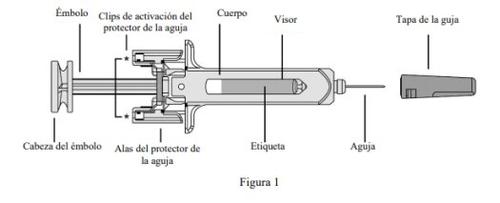
- Проверьте количество предварительно заполненных шприц-инъекторов и подготовьте материалы: Подготовка к использованию предварительно заполненного шприца-инъектора
- Удалите шприц-инъектор(ы) из холодильника. Оставьте предварительно заполненный шприц-инъектор вне коробки в течение 30 минут. Это позволит жидкости достичь комфортной температуры для введения (комнатная температура). Не удаляйте крышку иглы, пока ожидаете достижения комнатной температуры.
- Держите предварительно заполненный шприц-инъектор за корпус с закрытой иглой, направленной вверх.
- Не держите шприц-инъектор за головку поршня, поршень, крылья защитника иглы или крышку иглы.
- Не удаляйте поршень ни в коем случае.
- Не удаляйте крышку предварительно заполненного шприца-инъектора, пока вам не будет указано.
- Не трогайте клипсы активации защитника иглы (обозначенные звездочками* на Фигуре 1), чтобы избежать преждевременного закрытия защитника иглы.
- Не используйте предварительно заполненный шприц-инъектор, если он упал на твердую поверхность.
Проверьте предварительно заполненный(е) шприц-инъектор(ы), чтобы убедиться, что
- Количество предварительно заполненных шприц-инъекторов и концентрация правильны
- Если ваша доза составляет 45 мг, у вас будет один предварительно заполненный шприц-инъектор по 45 мг Отульфи.
- Если ваша доза составляет 90 мг, у вас будут два предварительно заполненных шприца-инъектора по 45 мг Отульфи, и вам необходимо будет сделать две инъекции. Выберите два разных места для этих инъекций (например, одно на правом бедре и другое на левом бедре) и сделайте инъекции одну за другой.
- Это правильное лекарство.
- Дата истечения срока годности не прошла.
- Предварительно заполненный шприц-инъектор не поврежден.
- Раствор в предварительно заполненном шприце-инъекторе прозрачный и бесцветный или слегка коричнево-желтый.
- Раствор в предварительно заполненном шприце-инъекторе не имеет необычного цвета, не мутный и не содержит посторонних частиц.
- Раствор в предварительно заполненном шприце-инъекторе не заморожен.
Подготовьте все необходимое оборудование и положите его на чистую поверхность, включая антисептические салфетки, вату или марлю и контейнер для острых предметов.
- Выберите и подготовьте место инъекции:
Выберите место инъекции (см. Фигуру 2).
- Отульфи вводится путем инъекции под кожу (подкожно).
- Некоторые подходящие места для инъекции – верхняя часть бедра или область живота (абдомен) как минимум на 5 см от пупка.
- По возможности не используйте области кожи, которые показывают признаки псориаза.
- Если кто-то другой вводит вам инъекцию, то он также может выбрать верхнюю часть руки в качестве места инъекции.
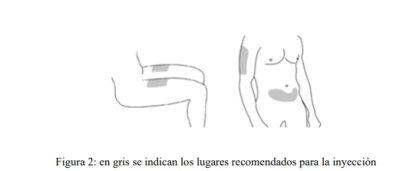
Подготовьте место инъекции
- Тщательно вымойте руки с мылом и теплой водой.
- Очистите кожу в месте инъекции антисептической салфеткой.
- Не трогайте эту область снова перед инъекцией.
- Удалите крышку иглы (см. Фигуру 3):
- Крышка иглы недолжна быть удалена, пока вы не будете готовы сделать инъекцию.
- Держите предварительно заполненный шприц-инъектор и держите корпус предварительно заполненного шприца-инъектора одной рукой.
- Удалите крышку иглы и выбросьте ее. Не трогайте поршень, делая это

- Возможно, вы заметите воздушный пузырек в предварительно заполненном шприце-инъекторе или каплю жидкости на конце иглы. Оба варианта нормальны и не требуют удаления.
- Не трогайте иглу и не позволяйте ей касаться любой поверхности.
- Не используйте предварительно заполненный шприц-инъектор, если он упал без крышки иглы. Если это происходит, сообщите вашему врачу или фармацевту.
- Введение дозы должно быть сделано сразу после удаления крышки иглы.
- Введение дозы:
- Держите предварительно заполненный шприц-инъектор одной рукой между указательным и средним пальцами, положите большой палец на головку поршня и другой рукой аккуратно зажмите кожный склад на месте инъекции большим и указательным пальцами. Не сжимайте.
- Не удаляйте поршень ни в коем случае.
- С одним быстрым движением введите иглу через кожу до тех пор, пока она не войдет полностью (см. Фигуру 4).
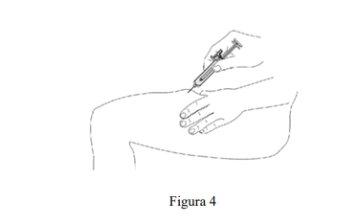
- Введение всего лекарства путем продвижения поршня до тех пор, пока головка поршня не окажется полностью между крыльями защитника иглы (см. Фигуру 5).
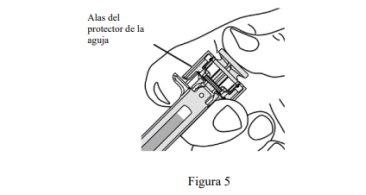
- Когда вы продвинете поршень до предела, поддерживайте давление на головку поршня, удалите иглу и отпустите кожу (см. Фигуру 6).
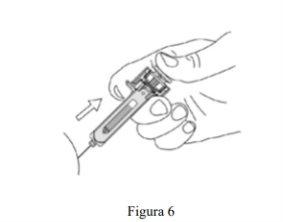
- Медленно удалите большой палец с головки поршня, чтобы пустой шприц-инъектор мог продвинуться до тех пор, пока игла не окажется полностью закрыта защитником иглы, как показано на Фигуре 7:
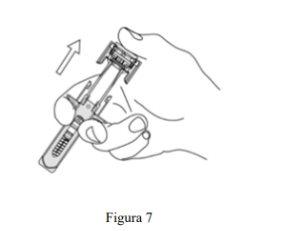
- После инъекции:
- Нажмите на место инъекции антисептической салфеткой в течение нескольких секунд после инъекции.
- Может появиться небольшое количество крови или жидкости в месте инъекции. Это нормально.
- Вы можете нажать на место инъекции ватой или марлей и держать в течение 10 секунд.
- Не трите кожу в месте инъекции. Вы можете покрыть место инъекции пластырем, если необходимо.
- Утилизация:
- Использованные шприцы-инъекторы должны быть помещены в контейнер, устойчивый к проколам, подобный контейнеру для острых предметов (см. Фигуру 8). Для вашей безопасности и здоровья, а также для безопасности других, никогда не используйте шприц-инъектор повторно. Утилизируйте контейнер для острых предметов в соответствии с местными правилами.
- Антисептические салфетки и другие материалы могут быть выброшены в мусор.

- Страна регистрации
- Активное вещество
- Требуется рецептДа
- Производитель
- Информация носит справочный характер и не является медицинской рекомендацией. Перед приемом любых препаратов проконсультируйтесь с врачом. Oladoctor не несет ответственности за медицинские решения, принятые на основе этого контента.
- Аналоги ОТУЛЬФИ 45 мг РАСТВОР ДЛЯ ИНЪЕКЦИЙ В ПРЕДНАПОЛНЕННОМ ШПРИЦЕФорма выпуска: ИНЪЕКЦИОННЫЙ РАСТВОР ДЛЯ ИНФУЗИЙ, 130 мгАктивное вещество: УстекинумабПроизводитель: Accord Healthcare S.L.U.Требуется рецептФорма выпуска: ИНЪЕКЦИОННЫЙ РАСТВОР, 45 мгАктивное вещество: УстекинумабПроизводитель: Accord Healthcare S.L.U.Требуется рецептФорма выпуска: ИНЪЕКЦИОННЫЙ РАСТВОР, 90 мгАктивное вещество: УстекинумабПроизводитель: Accord Healthcare S.L.U.Требуется рецепт
Врачи онлайн по ОТУЛЬФИ 45 мг РАСТВОР ДЛЯ ИНЪЕКЦИЙ В ПРЕДНАПОЛНЕННОМ ШПРИЦЕ
Консультация по дозировке, побочным эффектам, взаимодействиям, противопоказаниям и продлению рецепта на ОТУЛЬФИ 45 мг РАСТВОР ДЛЯ ИНЪЕКЦИЙ В ПРЕДНАПОЛНЕННОМ ШПРИЦЕ – по решению врача и с учетом местных правил.






